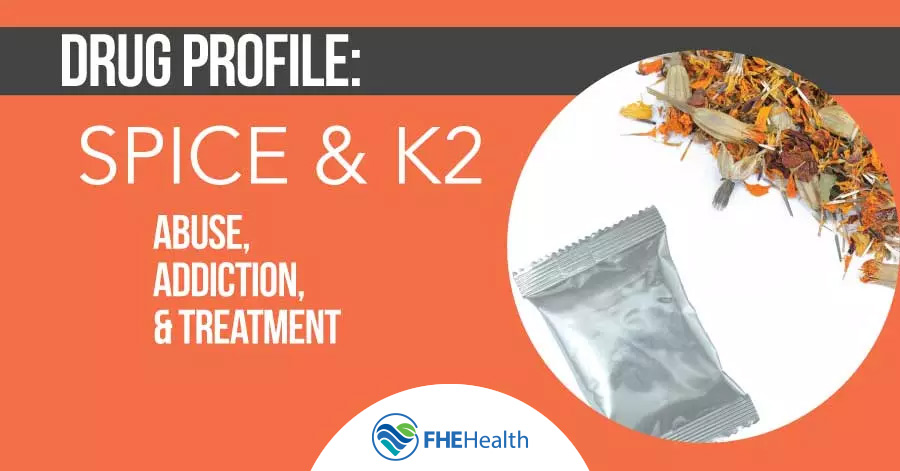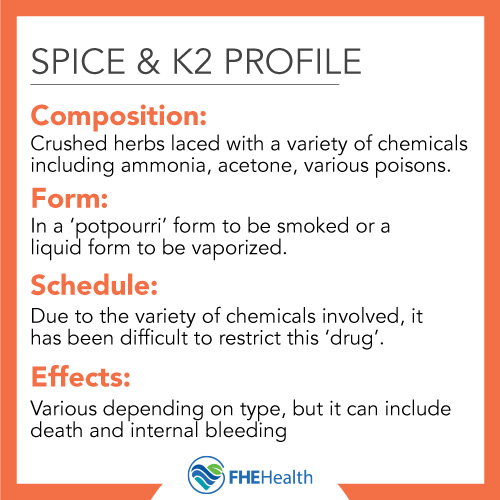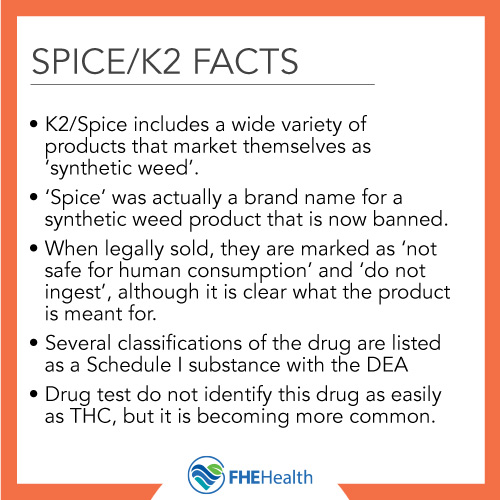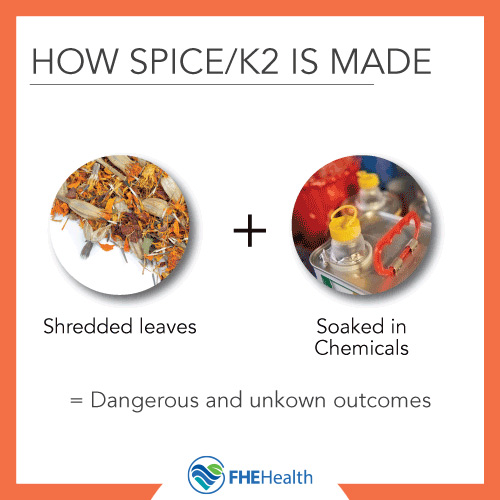
|
|
K2, also known as Spice, is a combination of industrial chemicals that are combined to create a dangerous street drug. It can either be vaporized in liquid form or smoked when added to dried herbs, similar to how marijuana is used.
This ‘fake weed’ is usually sold in small packets containing dried, chemical-laced organic materials such as dried flowers that drug manufacturers have been known to steal from cemeteries. Tobacco, dried grape leaves, and marshmallow leaf are popular among fake marijuana manufacturers as well. Virtually any kind of dried plant material can be used to make Spice, since the active compounds in the drug come from the chemical coating, not the actual dried organic material.
Liquid K2 is designed to be vaporized in e-cigarettes and it is often mixed with alcohol, while the dried form of Spice can be steeped in hot water to make a potent, drinkable tea. There are numerous reports of drug dealers combining synthetic weed with organic marijuana in order to entice users into believing they are purchasing a high-THC form of organic cannabis rather than K2.
The K2 drug has made headlines in recent years for causing city-wide overdoses among users who suffered from shocking symptoms ranging from delirium and violent behavior to seizures, strokes, respiratory and cardiac distress, and death. K2 incense is often referred to as the “zombie drug” due to the tendency for users to behave in ways that mimic portrayals of zombies on TV and in the movies.
K2 use has been particularly rampant in low-income areas thanks to the fact that a single dose can be purchased for just a few dollars. Spice is also known to be a drug of choice among parolees, military personnel, and athletes who struggle with substance abuse. This is because the K2 drug is virtually undetectable through standard urine, saliva, and blood drug testing, making it easier for Spice users to pass mandatory drug tests.
What Is K2/Spice?
 K2, or Spice, goes by a number of different street names including, synthetic marijuana, synthetic weed, mojo drug, and fake weed. It’s also sometimes called synthetic CBD, smokable incense, or liquid K2.
K2, or Spice, goes by a number of different street names including, synthetic marijuana, synthetic weed, mojo drug, and fake weed. It’s also sometimes called synthetic CBD, smokable incense, or liquid K2.
K2 was reportedly first developed during the 1990s by John W. Huffman, a South Carolina chemist. He was working to create a substance that mimicked the therapeutic effects of cannabinoids found in marijuana, and he published his findings and his manufacturing methods in the mid-2000s in a scientific journal.
Huffman’s findings were widely distributed and used to create a combination of liquid chemicals known as liquid K2. This liquid was sprayed on dried herbs and sold in corner stores, head shops, and online for a fraction of the price of real marijuana. Savvy manufacturers would frequently label Spice as “not for human consumption” or call Spice “potpourri” to avoid prosecution by authorities.
Technically speaking, Spice is still legal at the federal level simply because it’s not actually a single drug— it’s a blend of common chemicals that can include ammonia, acetone (nail polish remover), rubbing alcohol, and even rat poison.
In an effort to combat Spice abuse and overdoses caused by K2, the sale of synthetic weed possession and production has been banned in a number of cities and states, including New York State, Texas, and Kansas. Despite these bans, Spice can still be purchased with relative ease in retail locations, online, and through street-level drug dealers throughout the country.
In April 2017, the Drug Enforcement Agency (DEA) placed six of the most common Spice ingredients on a temporary Schedule 1 ban in an effort to criminalize the purchase and possession of synthetic marijuana. It’s unclear if limiting access to these chemicals has helped to curb Spice production, however, and some experts believe this approach may contribute to the uncertainty of what’s in each batch of K2.
The Effects of Synthetic Marijuana
While many people expect synthetic weed to deliver similar effects to regular, organic marijuana, the fact is that their expectations are rarely met. This is due to the fact that unlike cannabis, Spice is not a natural substance— it’s a substance that is comprised of a variety of highly toxic chemicals. The actual formulation used to create each batch of K2 varies a great deal depending on the drug dealer and the availability of the ingredients.
Because the actual chemicals and quantities vary in Spice, it’s impossible for users to accurately predict how the drugs will impact them. Some of the chemicals found in Spice have included rat poison. In the spring of 2018, a batch of poison-laced synthetic weed was sold throughout the Midwest and the Eastern Seaboard, resulting in at least three deaths and over 100 reports of uncontrolled internal bleeding.
In August 2018, more than 100 K2 users in New Haven, Connecticut overdosed on the substance, suffering from symptoms that included dangerously high heart rates, respiratory distress, vomiting, and loss of consciousness. In the same year, synthetic weed was linked to 56 cases of severe internal bleeding and four deaths in the Chicago area, and 33 people spontaneously collapsed in New York City after using Spice.
K2 use has become a serious issue at Florida Department of Corrections facilities, where there’s been a dramatic spike in inmate deaths. The Miami Herald reported that, “The top killer, according to an internal FDC audit” was “synthetic marijuana.” In response to the problem, the FDC produced an educational video highlighting the dangers of synthetic cannabis use that all inmates must watch, and new anti-smuggling measures are being introduced throughout the correctional system.
Although deaths from K2 use are still relatively rare in comparison to alcohol, opioids, and other street drugs, a number of life-threatening poisonings have been positively linked to Spice use throughout the country. In many cases, the side effects of fake weed wear off relatively quickly, although many addictions experts and law enforcement personnel have long suspected that the rates of spice abuse are significantly higher than what is reported.
The lack of clear statistics around Spice abuse is largely attributed to the fact that Spice users are often either homeless or members of marginalized communities where access to addiction services and health care is limited.
Is Spice Addictive?
 Like any substance that offers a mind-altering experience, Spice can create a behavioral addiction linked to use. Many users of smokable incense report experiencing effects that are similar to marijuana, such as relaxation, altered perception, and a feeling of calm.
Like any substance that offers a mind-altering experience, Spice can create a behavioral addiction linked to use. Many users of smokable incense report experiencing effects that are similar to marijuana, such as relaxation, altered perception, and a feeling of calm.
Chronic Spice users report developing a tolerance over time, which is one of the hallmarks of addiction to a substance or drug. Many users also develop a behavioral dependence on K2— they use Spice in order to manage the symptoms of mental health issues such as depression, anxiety, or post-traumatic stress disorder (PTSD).
Signs of Spice/K2 Addiction
Spice addiction is characterized mostly by drug-seeking behaviors. Regular K2 users report experiencing uncomfortable physical withdrawal symptoms that can include headaches, irritability, insomnia, depression, and anxiety if they attempt to quit using fake weed.
Like all people who struggle with addiction, Spice addicts will gradually shift their actions to focus on getting and using K2. This could involve engaging in behaviors that they previously viewed as being distasteful or immoral in order to get their fix, such as stealing, taking part in sexual exploitation, or even becoming drug dealers. Some Spice users also attempt to formulate their own fake weed using household chemicals and instructions sourced online.
Concerned About Your K2 Use? Call Us
If you’ve been using Spice and you want help quitting, call us at FHE Health. We are a fully licensed and accredited addiction and mental health treatment center where you can get the personalized, life-saving treatments you need to get well.







